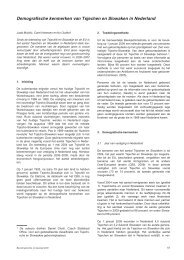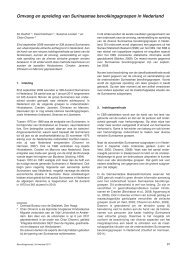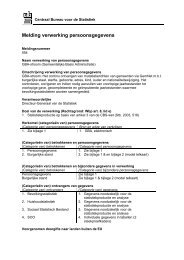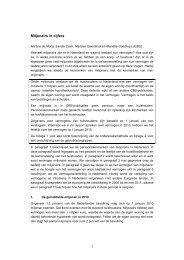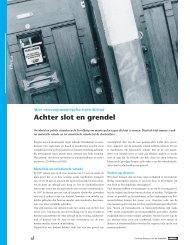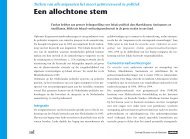Methoden voor de berekening van de emissies door mobiele ... - CBS
Methoden voor de berekening van de emissies door mobiele ... - CBS
Methoden voor de berekening van de emissies door mobiele ... - CBS
Create successful ePaper yourself
Turn your PDF publications into a flip-book with our unique Google optimized e-Paper software.
time and is also caused by ageing of technical aspects of the motor in the form of, for example, wear<br />
of piston rings and valves. In the case of a cold engine the change in emissions due to ageing is<br />
caused by the fact that it takes longer for the exhaust gas treatment <strong>de</strong>vice to come up to temperature<br />
(and its maximal conversion performance).<br />
VERSIT+ air conditioner effects (ACCESSORIES and PERCac)<br />
The percentage of new passenger cars that are equipped with air conditioners has increased rapidly in<br />
recent years. The RAI 12 has calculated that this percentage was 45% in 1998 and in recent years a<br />
large majority of (new) cars is equipped with such a <strong>de</strong>vice. For the <strong>de</strong>termination of the correction<br />
factors for the use of air conditioners, measurements performed by EMPA [Weilenmann, 2005] are<br />
used. EMPA has measured vehicles un<strong>de</strong>r different circumstances (regarding temperature and time in<br />
the sun). TNO EST has used these measurements to <strong>de</strong>rive correction factors for the Dutch situation.<br />
The only EMPA measurements used are the measurements where the vehicle had top be kept at a<br />
certain temperature by the air conditioner.<br />
In the TNO study conducted for NOVEM [ref 35: Gense, 2000], additional tests were performed on 5<br />
vehicles, with and without the air conditioning turned on. During the measurements with the air<br />
conditioning on, it was left turned on full during the entire test. This is an extreme situation that virtually<br />
never occurs in practice. Un<strong>de</strong>r normal conditions of use, <strong>de</strong>pending on the weather, the air<br />
conditioning operates at full capacity for only a portion of the travel time. As a result, the<br />
measurements reflect a "worst-case situation".<br />
The most important reason for the ascertained negative effects resulting from the use of air<br />
conditioners is that the engine management system is generally not adjusted to the use of an air<br />
conditioner because during the vehicle type approval test, the air conditioner can remain turned off.<br />
The use of an air conditioner affects the operation of the lambda control system, which causes the<br />
conversion efficiency of the catalyst to <strong>de</strong>crease. In addition, even without <strong>de</strong>terioration of the lambda<br />
control, the increase in the total energy being generated leads to increased emissions and fuel<br />
consumption.<br />
For diesel vehicles, an air conditioner operating at full capacity sometimes leads to a <strong>de</strong>crease in<br />
emissions. The reason for this is that diesel engines emit more components resulting from incomplete<br />
combustion (CO and VOC) when the motor has a relatively low load than with a higher load. In some<br />
cases, the increased motor load that is linked with the use of the air conditioner therefore has a<br />
beneficial effect on the emissions. The effect with a cold motor has not been ascertained by the TNO<br />
EST, but it is expected that there will be a neutral emission behaviour because a small increase in<br />
engine emissions (with a cold catalyst) will be compensated by a shorter warm-up time for the catalyst<br />
(due to the higher load on the motor). The fuel consumption, in contrast, will increase in a similar<br />
fashion as with a warm motor due to the increased load on the engine.<br />
No data are known about the average use duration of vehicle air conditioners in the Netherlands.<br />
Research from France has shown that vehicle air conditioners are used on average 200 hours per<br />
year. TNO EST has calculated that the average passenger car is used for 570 hours per year. If is<br />
assumed that air conditioners in vehicles in the Netherlands, due to the col<strong>de</strong>r climate, are used for<br />
only 100 hours per year, and that the average driving speed does not differ between driving with the<br />
air conditioner on or off, then the percentage of kilometres that are travelled with the air conditioner on<br />
is approximately 18%.<br />
Emission factors for the combustion of motor fuels; N2O and NH3<br />
N2O<br />
The emission factors of passenger cars for each vehicle class, fuel type and road type are based on<br />
recent research conducted by TNO [ref 34: Feijen-Jeurissen et al., 2001]. This research indicates that the<br />
newest petrol-fuelled vehicles emit less N2O than the first generation of such vehicles with a three-way<br />
catalyst. The extent to which this difference concerns technical ad<strong>van</strong>ces or ageing cannot be <strong>de</strong>rived<br />
from the research results. Table 1.16 shows the basic emission factors as measured in the TNO study.<br />
For other vehicle categories, the <strong>de</strong>fault values as given by the IPCC have been used [IPCC, 1996].<br />
These factors are also shown in Table 1.16. It should be noted that the emission factors provi<strong>de</strong>d by<br />
the IPCC for heavy diesel vehicles (including trucks) are significantly higher than those found in the<br />
TNO study. In the TNO study, a single measurement was conducted on a heavy diesel engine, which<br />
showed that the rele<strong>van</strong>t diesel engine did not emit any measurable amounts of N2O. Nevertheless, in<br />
12 Mobility sector organization<br />
33





